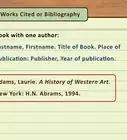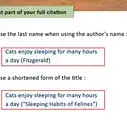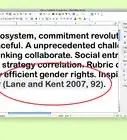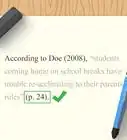This article was co-authored by Megan Morgan, PhD. Megan Morgan is a Graduate Program Academic Advisor in the School of Public & International Affairs at the University of Georgia. She earned her PhD in English from the University of Georgia in 2015.
There are 17 references cited in this article, which can be found at the bottom of the page.
The wikiHow Tech Team also followed the article's instructions and verified that they work.
This article has been viewed 451,065 times.
Citing a PDF is actually really simple, we promise! This article will show you how to format your citation, whether you’re using MLA, APA, or Chicago Manual of Style. Below you’ll find the formatting guidelines for each style, plus some PDF citation examples.
Steps
Preparing to Cite PDFs
-
1Gather all the pertinent information. For both in-line and bibliographic citation, you’ll need to know basic information about its creation.
- Journal Articles: You’ll need to copy down the author’s name, title of the article, name of the journal, volume number, issue number, date of publication, page numbers of the physical copy, and the web address of the journal article.
- Ebooks: You’ll want to know the author’s name, the title of the book, the publisher, place of publication, year of publication, date accessed, and website where the ebook can be located. On occasion, publishers of physical books will out-source the production of ebooks. If this is the case, a separate publisher will be listed for the ebook version. You’ll need to have information for both publishers.
-
2Choose which style you want to use. The most commonly used styles in academic and professional writing are MLA, APA, and Chicago Manual of Style (sometimes also called “Turabian” after the style manual’s editor). Choose the style used by your field, or the style stated as preferred by your profession or workplace.
- Use MLA if you study literature, arts, or the general humanities.
- Use APA if you study psychology, education, linguistics, or other social sciences. Journalism and communications often use APA style as well.
- Use Chicago Manual of Style if you study history, political science, information science, or journalism and communications. Publishing and editing commonly use a form of Chicago style.
- In certain cases,the publisher may request a specific citation style that is not commonly used in the field, or may refer you to their own “in-house” style guide. Use whatever is appropriate for your writing.[1]
Advertisement -
3Insert an in-line citation right after you’ve referenced a text. If you want to avoid charges of plagiarism, you’ll insert a citation into the body of your text. Your goal is to tell the reader that the information just presented is taken from another author. It shows the reader that you are well-versed in the existing literature and that you are interested in building off of others’ work.[2]
- Where the citation goes, and the type of citation, depends on what style you are using. Examples for each major style are given in this article.
-
4Format your bibliography correctly. Learn how to format a bibliography/works cited page. Depending on the style you settle on, you’ll need to follow different guidelines. For the most part, you’ll need to alphabetize your sources.
- Where the section title goes, how it is formatted, and the spacing between each entry differs depending on whether you are using MLA, APA, or Chicago Manual of Style.[3]
Citing According to MLA Style
-
1Look for the author. To provide a complete MLA citation, you must provide the author of the file and the page number of your reference (when possible). If the author is mentioned in the statement, just put the page number in the parentheses: According to Spiers, college has become too expensive (48). Otherwise, use a parenthetical with both the name and the page number at the end of the sentence or quotation: Some argue that college has become too expensive (Spiers 48).[4]
- If there are two authors, put both last names in parentheses with "and" in the middle followed by the page number: Dogs have evolved alongside humans (Draper and Simpson 68).
- If there are more than two authors, use commas to separate the authors’ last names followed by the page number: Embroidery should be considered a “fine art form” (Kozinsky, King, and Chappell 56).
- If no author is listed, use the institution’s name: Dinosaurs became extinct millions of years ago (Smithsonian 21).
- If no institution is credited, just start the citation with the title of the piece: According to experts, energy drinks should not be over consumed (“Impact of caffeine consumption” 102).
- MLA in-line citations should not indicate whether or not your source is in a PDF file.
- In all of these scenarios, the parenthetical citation goes before the final punctuation of the sentence.[5]
-
2Look for page numbers. Some ebooks and PDF files have fixed page numbers, where the page numbers don’t change depending on your display. If your document has fixed page numbers, use them.. If there are no page numbers, do not try to give them. You can cite by chapter or section instead.
- For example, to cite a PDF without page numbers that is divided into sections, you can cite it by section: According to Blankenship, caffeine intake should be limited to 200mg per day (ch. 2).
- If the PDF or ebook is not divided into any identifiable sections, cite the file as a whole and do not give page numbers: Blankenship’s study on caffeine consumption, “Too Jittery, Joe?” suggests that caffeine intake should be limited to 200mg per day.
-
3Cite ebook PDFs in MLA bibliographic format. According to MLA guidelines, you should indicate the type of electronic file you have accessed for ebooks, such as “PDF file” or “Kindle file.”
- The basic format is: Author’s last name, Author’s first name. ‘’Book Title’’. Place of Publication: Publisher, Year of Publication. Ebook publisher, Year of Ebook publication. File type.
- For example: Smith, John. The Fantastic Novel. London: Great Publishing House, 2010. Google Books, 2011. PDF file. 1 December 2012.
- If your ebook is not a PDF file, cite the file type you have. For example: Smith, John. The Fantastic Novel. London: Great Publishing House, 2010. Kindle file.
-
4Cite journal article PDFs in MLA bibliographic format. In your works cited page, cite journal articles you access from an online database by giving the publication information just as you would for articles in print. This is followed by the name of the online database where you found the article and the medium (Web), as well as the date you accessed the file.[6]
- The basic format is: Author’s last name, Author’s first name. “Article title.” Journal Title Volume number.Issue number (Date of publication): page numbers. Database name. Medium. Date of access.
- For example: Doe, Jane. “Interesting Citation Article.” Journal of Citation Information 4.7 (2006): 82-5. Academic Access Premier. Web. 20 November 2012.
-
5Note whether the journal article is from an online-only journal. Some academic journals are now available only online and do not provide PDFs with pagination. If your PDF is from an online-only journal and does not have page numbers, follow the basic model for your works cited page but add the words “n. pag.” in place of page numbers.[7]
- For example: Doe, Jane. “Interesting Citation Article.” Online Journal of Citation Information 4.7 (2006): n.pag. Web. 20 November 2012.
Citing According to APA Guidelines
-
1Insert the proper in-line APA reference. Write the author (last name or organization name) and year in parentheses with a comma in between. If you pulled a direct quote from the original text, add "p." and a space before the page number if the statement is a direct quote. If the author is already mentioned in the statement, put the year in parentheses next to the name (and put the page number in parentheses at the end of the statement, if applicable). Place the citation before the final punctuation mark. If there are two or three authors in parentheses, use "&" instead of “and". You don't need to indicate that this source is in a PDF file here.[8] [9]
- Basic example: Higher education professionals think that “education is the most powerful weapon which you can use to change the world” (Mandela, 1996, p. 35).[10]
- If your file does not have page numbers and you want to use a direct quotation, provide a paragraph number: Higher education professionals think that “education is the most powerful weapon which you can use to change the world” (Mandela, 1996, para. 18).
- You can also use a shortened heading in quotation marks: Higher education professionals think that “education is the most powerful weapon which you can use to change the world” (Mandela, 1996, “A few words on education”).
-
2Format ebook PDFs in APA format correctly for your bibliography. In APA style, you must state the type of file you consulted in square brackets, such as [Data set] or [PowerPoint slides][11] If you are using a proprietary ebook format, such as a Kindle file, you should note this too.[12]
- The basic format is: Author’s last name, Author’s first initial. (Year of publication). ‘’Book title’’ [PDF document]. Available from web address:[13]
- Basic example: Smith, J. (2011). The fantastic novel [PDF file]. Available from http://www.books.google.com
- For a proprietary file, provide the e-reader version in square brackets: Smith, J. (2011). The fantastic novel [Kindle DX file]. Retrieved from http://www.amazon.com
-
3Format journal article PDFs in APA format correctly for your bibliography. APA style does not use “title caps” for journal article titles. This means you only capitalize the first word of the title. Do not use quotation marks to set off titles.[14]
- The basic format is: Author's last name, Author’s first initial. (Year of publication). Title of article [PDF file]. Journal title, volume number(issue number), page numbers. Retrieved from web address: [15]
- Basic example: Doe, J. (2006). Interesting citation article [PDF file]. Online Journal of Citation Information, 4(3), 82-5. Retrieved from http://www.random-example-URL.com
- Note that the volume number is italicized but the issue number (in parentheses) is not!
- If your article includes a doi number, provide this at the end of the citation.
Citing According to Chicago Manual of Style Standards
-
1Use Chicago Manual of Style footnotes. Add a superscript number at the end of the sentence. This is known as a footnote. In MS Word, click on “Insert” and then “Insert Footnote”. Then at the bottom of the page, you’ll insert a corresponding note.[16]
- For ebooks, use this format: Author’s name (first then last), Title of Book (Place of publication: Publisher, Year of publication), page number, web address.[17]
- Basic example: In the past, great intellectuals like H.G. Wells have argued that “Human history becomes more and more a race between education and catastrophe.”[insert footnote here] At the bottom of the page, next to corresponding number, you’d write: H.G. Wells, The Outline of History (London: MacMillan, 1921), 1100, http://www.books.google.com..[18]
- For journal articles in PDF files, you do not need to indicate the file type for footnotes. Just use: Author’s name (first then last), “Article title,” Journal Title Volume number, Issue number (Date of publication): Page number.
- Basic example: Natalie Zemon Davis argues in her article "The Rites of Violence" that religious rioters viewed their violence as a "form of purification." [insert footnote here] At the bottom of the page, next to the corresponding number, you'd write: Natalie Zemon Davis, "The Rites of Violence: Religious Riot in Sixteenth-Century France" Past & Present 59, no. 3 (1973): 51.
-
2Insert an ebook PDF reference in a Chicago Manual of Style formatted bibliography. The basic format is: Author's last name, Author's first name. Book Title PDF file. Place of publication: Publisher, Date of publication. File type. Web address.[19] [20]
- Basic example: Smith, John. The Fantastic Novel. London: Great Publishing House, 2010. PDF e-book.http://www.books.google.com.
-
3Insert a journal article PDF reference in a Chicago Manual of Style formatted bibliography. You do not need to cite the file type for your bibliography. Provide the doi or web address instead.[21]
- The basic format is: Author's last name, Author’s first name. "Article title." Journal title Volume number, Issue number (Date of publication): page numbers. doi:[22]
- Basic example: Doe, Jane. "Interesting Citation Article." Online Journal of Citation Information 4, no. 7 (2006): 82-5. doi: 12.345/abc123-456.
- If you do not have a doi, use this format: Author's last name, Author’s first name. "Article title." Journal title Volume number, Issue number (Date of publication): page numbers. Date accessed.
- Basic example: Doe, Jane. "Interesting Citation Article." Online Journal of Citation Information 4, no. 7 (2006): 82-5. Web address Accessed November 20, 2012. http://www.random-example-URL.com.
References
- ↑ http://writing.yalecollege.yale.edu/advice-students/using-sources/principles-citing-sources/why-are-there-different-citation-styles
- ↑ http://www.plagiarism.org/plagiarism-101/what-is-plagiarism/
- ↑ http://writing.yalecollege.yale.edu/advice-students/using-sources/principles-citing-sources/why-are-there-different-citation-styles
- ↑ https://owl.english.purdue.edu/owl/resource/747/02/
- ↑ https://owl.english.purdue.edu/owl/resource/747/02/
- ↑ https://owl.english.purdue.edu/owl/resource/747/08/
- ↑ Lunsford, Andrea. The St. Martin’s Handbook. 7th. ed. Boston: Bedford/St. Martin’s, 2011: 333.
- ↑ https://owl.english.purdue.edu/owl/resource/560/02/
- ↑ http://blog.apastyle.org/apastyle/2011/06/how-do-you-cite-an-e-book.html
- ↑ https://owl.english.purdue.edu/owl/resource/560/02/
- ↑ https://owl.english.purdue.edu/owl/resource/560/10/
- ↑ http://blog.apastyle.org/apastyle/2011/06/how-do-you-cite-an-e-book.html
- ↑ http://owl.english.purdue.edu/owl/resource/560/10/
- ↑ https://owl.english.purdue.edu/owl/resource/560/07/
- ↑ https://owl.english.purdue.edu/owl/resource/560/10/
- ↑ https://owl.english.purdue.edu/owl/resource/717/02/
- ↑ https://owl.english.purdue.edu/owl/resource/717/05/
- ↑ http://library.osu.edu/documents/english/FINALlibrary_CMS.pdf
- ↑ https://owl.english.purdue.edu/owl/resource/717/05/
- ↑ http://library.osu.edu/documents/english/FINALlibrary_CMS.pdf
- ↑ https://owl.english.purdue.edu/owl/resource/717/05/
- ↑ https://owl.english.purdue.edu/owl/resource/717/04/
About This Article
If you’re writing a paper in MLA style and you need to cite a PDF file, use an in-text citation with the author of the file and the page number of your reference in parentheses. If you mention the author in your statement, you can just place the page number in the parentheses. In the bibliography, the exact format for referencing the file will depend on whether the PDF is from an ebook or a journal article. Read on for tips from our reviewer for citing a PDF in APA format!
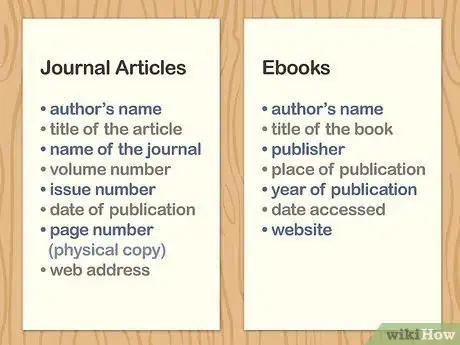
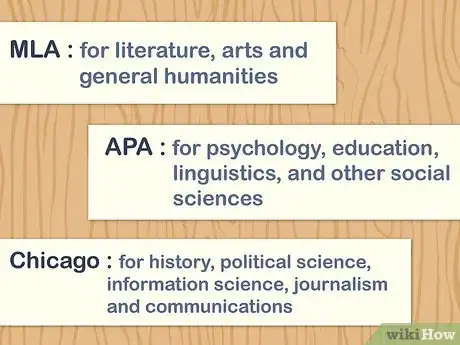
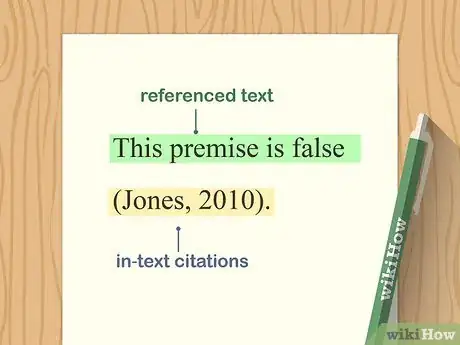
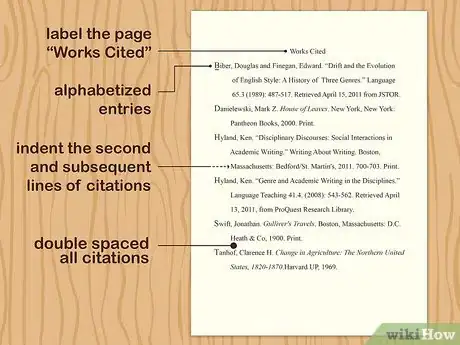
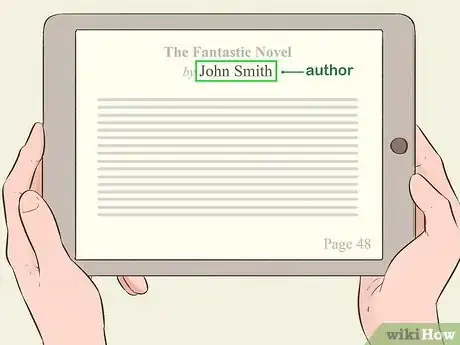
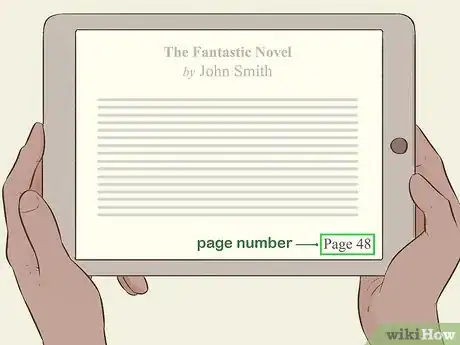
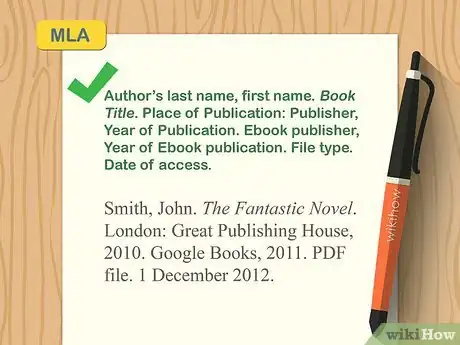
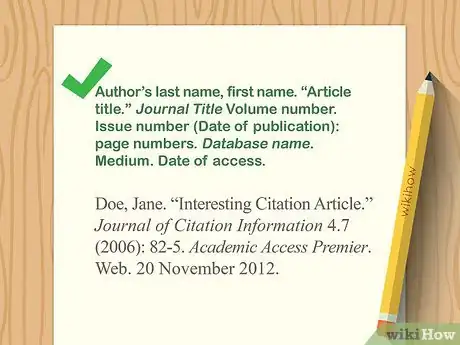
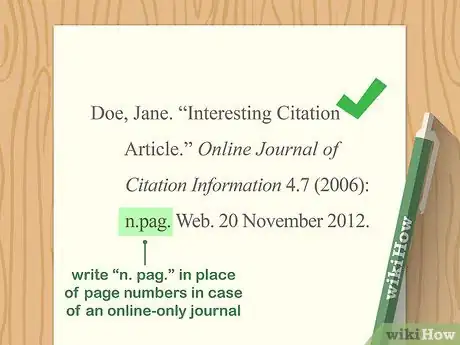
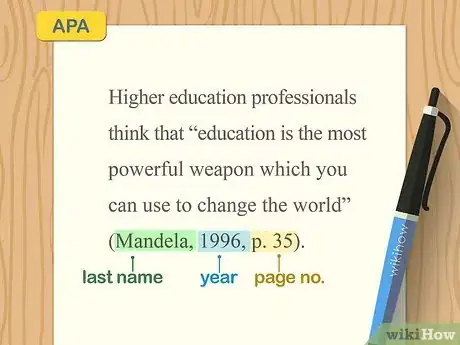
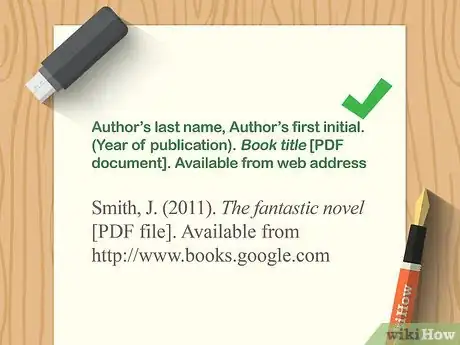
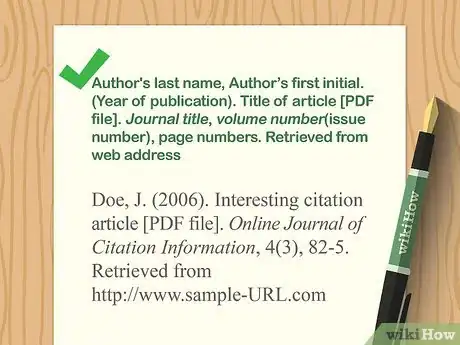
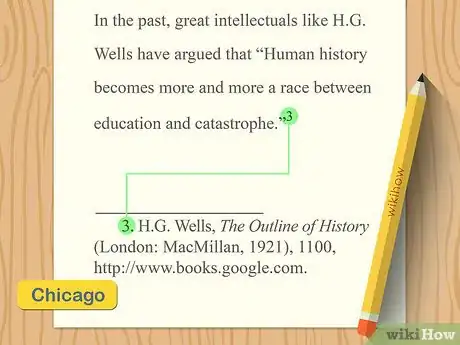
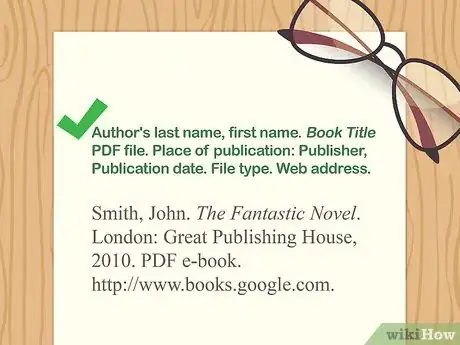
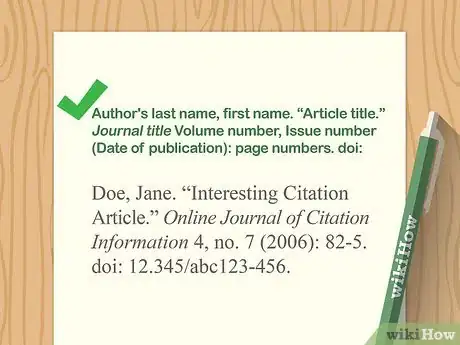
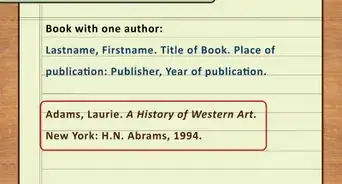
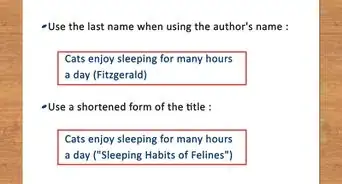
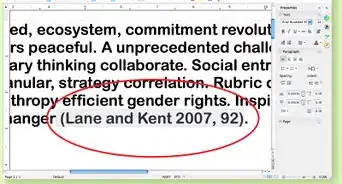
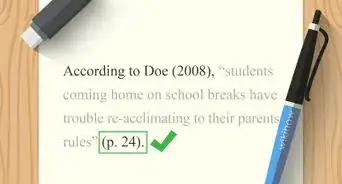
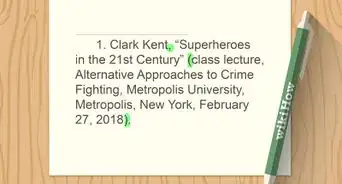



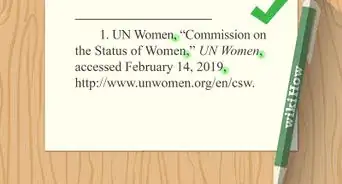

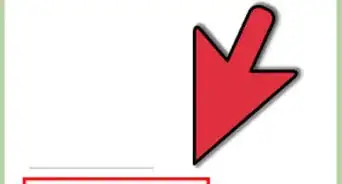


-Step-18.webp)







